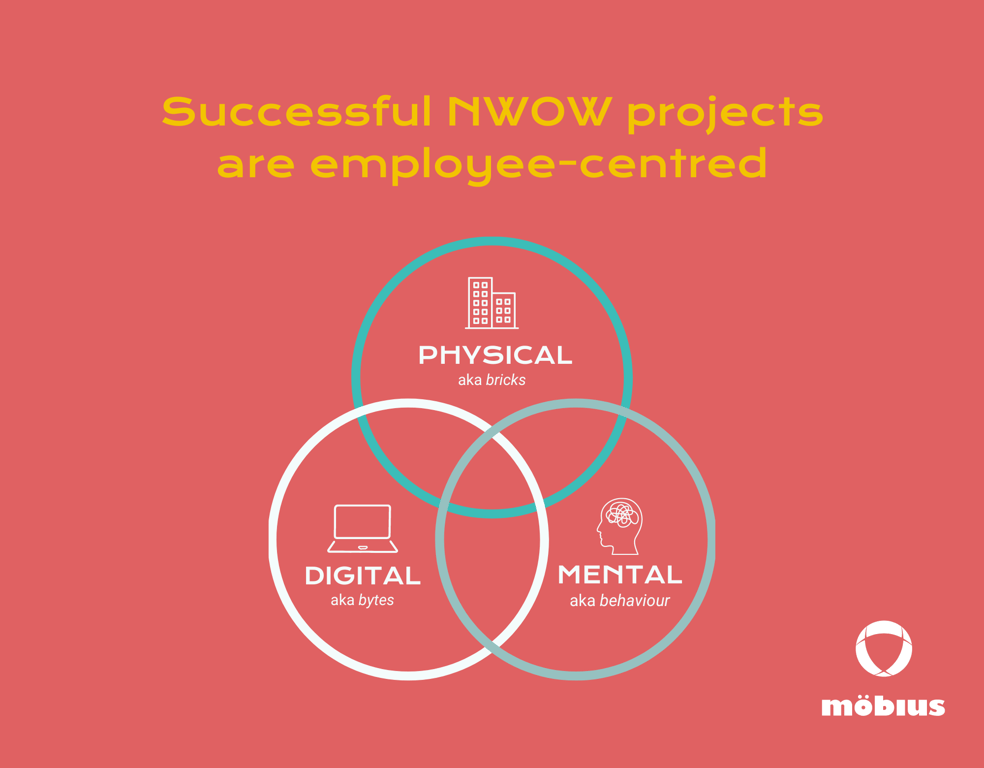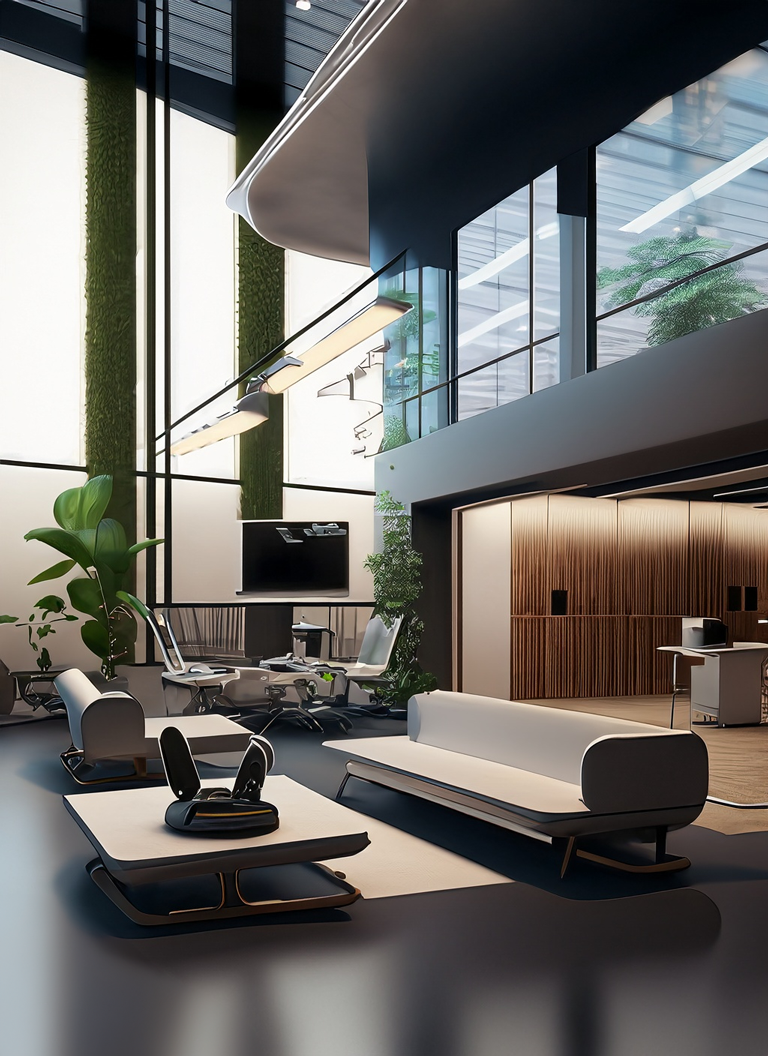I now have more than 15 years of experience with customer experience projects. My role in these projects is threefold. I help companies identify customer needs, design customer journeys, and improve their processes and services. In parallel, I helped improving employee experience in different companies by working on NWOW projects.
In both type of projects, I experienced the importance of proper program management and change management. And although each manager agrees with this, human nature and governance structures too often lead to failed transformations.
In this blog, I would like to share my experience on how to successfully implement New Ways of Working.
NWOW and Activity Based workspaces
NWOW projects focus on creating a positive work atmosphere. This encourages employee engagement and productivity, leading to improved business results.
With NWOW you aim for a motivating and engaging work culture but also a modern and pleasant working environment. Which has become even more important in today’s hybrid context where homeworking is part of our professional lives. A modern workplace should attract employees to come to the office to connect and collaborate. Empty work floors are not motivating and must be avoided.
This modern and engaging working environment should be tailored to the needs of both current and future employees (e.g. new hires). As organisations are constantly evolving in terms of structure and size, flexibility in workspace design becomes key.
Activity Based working
A standard concept used in modern offices is the so-called Activity Based workspace. Activity-Based Workspaces are designed to encourage employees to move throughout the day. This can be accomplished by providing a variety of room types, each fit for a different activity and within reasonable walking distance.
The introduction of a more diverse mix of room types has some consequences such as:
-
less traditional places such as standard dedicated work desks, private offices and classic meeting rooms
-
mutualisation or sharing of workspaces
-
introduction of a clean desk policy and lockers
-
less paper and personal belongings
Evolution of work culture
This evolution implicates a more autonomous work culture with a result driven management style. Managers and team members are no longer always sitting together. Employees are moving around in the office, and between locations. Hybrid working includes working at other company sites or from home. This implicates a modern leadership style which focuses on trust, autonomy and competences. Managers do not control processes but coach and monitor results. I have seen that Activity Based Working can only be successful in an environment that promotes the right company culture. This leads to a more engaged and satisfied workforce. Another important aspect is the digital aspect. The ideal hybrid workplace is intuitive with tools that facilitate connectivity and digital collaboration. The digital mindset is in place and process are digitized to allow a paperless way of working.
Employee-centred approach
Hence, successful NWOW projects are employee-centered and focus on finding the perfect symbiosis between the physical, digital, and mental work experience (also referred to as bricks, bytes & behaviour).

Wow, direct access to the end users!
Employee Experience projects are unique. As a consultant, you interact with both the employer and the employees. The employer shapes the overall vision and you design a new working experience for and with the employees.
This contrasts with customer experience projects where it's a challenge to access target populations, such as B2B clients and end consumers.
NWOW missions give you a great chance to connect with all employees. You can engage with them in the conceptual phase and in the implementation phase.
Gathering essential data and feedback
I am pleased to use my research experience during the design phase. This includes gathering essential data and objective feedback on new concepts and designs. We gather:
-
Quantitative data such as general occupancy rates, badging info, meeting room occupation, team sizes, and % homework
-
Qualitative data such as activity profiles and employee preferences via online surveys and focus groups
Creating requirements for architects and designers
We have collected data and feedback. Using this, we create a set of requirements for architects and designers. This will enable them to create a new activity-based environment.
During this fit-out phase, we engage with employees. We do this to decide on the design and consider how people will use the different workspaces. The biggest challenge during this period is finding ways to maximise flexibility in the new space layout to absorb future changes in terms of processes and team structure.
New habits
In parallel, we have to prepare both managers and employees for the new way of working. A hybrid, shared, and activity-based environment requires us to change our behaviour and the way we interact with colleagues. This is different from the traditional, dedicated, and/or closed office. This shift in mindset is often underestimated.
7 change tools to prepare employees
It is important to support managers and employees during the transition. Here are some change tools that we use to prepare employees for a new way of working:
-
Communication plan: A clear and comprehensive communication plan is essential during every transition. The plan should outline the purpose and benefits of the change, the timeline for implementation, and how it will impact employees. We keep employees informed and engaged throughout the process via regular updates and feedback sessions.
-
Sounding board: Interact with a diverse selection of employees. Consider different roles, functions, and personality types. Reflect on the concept of new space design, new principles, and ways to roll out the new habits effectively. Members of the sounding board are taking part in the concept phase. They can become project ambassadors during the implementation phase.
-
Training: Give employees training and development opportunities. This ensures they have the necessary skills and knowledge to work efficiently in the new environment. This includes workshops, online courses, and coaching sessions tailored to the specific needs of different teams.
-
Testing ground: A pilot program is an effective strategy. It allows us to test a new way of working but on a smaller scale. This way, we can implement it across the entire organisation with confidence. This allows employees to experience the new environment first-hand, provide feedback, and identify any potential issues.
-
Change ambassadors: Identifying and training ambassadors can help to build momentum and support for the new way of working. These individuals can act as advocates for the change, provide guidance and support to their colleagues, and help to address any concerns or resistance.
-
Team coaching: Train and support teams to successfully adapt their dynamics to a hybrid and activity-based way of working to maintain or improve both team efficiency and cohesion.
-
Feedback mechanisms: Providing employees with opportunities to provide feedback and input throughout the change process is essential for ensuring that their concerns and needs are addressed. This can include regular surveys, focus groups, and one-on-one meetings with managers.
Conclusion
NWOW projects are fun and serve a great purpose but they entail more than designing a new environment. It is about introducing a whole new way of collaborating and sharing office space. It also often comes with a lot of logistics and operational consequences such as temporary moves, centralising facilities, etc. This includes specialities like space design, interior design, acoustics, facility management, change agents, and communication experts. Coordinating such projects requires expert program and change management.






.png?width=410&height=220&name=employer-experience-zorg-sector-unie-k%20(1).png)


